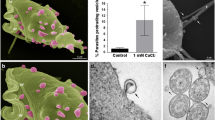Abstract
The mechanism of cytopathogenicity of Trichomonas vaginalis is not well established. Adhesion of T. vaginalis to human epithelial cells is considered a prerequisite for parasitic infection and its pathogenic effect. To investigate cytopathological changes in the host caused by T. vaginalis infection, human amnion membrane was used as an in vitro model. T. vaginalis strain WAA38 from axenic culture was allowed to interact with the epithelial layer of the human amnion membrane for 6 and 9 h. Structural changes resulting from the interaction between parasite and host cells were studied with transmission (TEM) and scanning (SEM) electron microscopy. Analysis of the electron microscope data showed that T. vaginalis established contact with the host cells as early as after 6 h of incubation; however, a close attachment of parasites to the epithelial cells occurred only after 9 h. Amoeboid T. vaginalis formed numerous cytoplasmic extensions and adhered to the epithelial cells mostly through the portions of their body opposite the undulating membrane. A dense network of microfilaments was seen at the site of contact between T. vaginalis and epithelial cells. Damaged and desquamated epithelial cells were seen with TEM and SEM only in the areas where parasites were in direct contact with target cells.
Similar content being viewed by others

References
Alderete JF, Garza GE (1985) Specific nature of Trichomonas vaginalis parasitism of host cell surface. Infect Immun 50:701–708
Alderete JF, Garza GE (1988) Indentification and properties of Trichomonas vaginalis proteins involved in cytadherence. Infect Immun 56:28–33
Alderete JF, Pearlman E (1984) Pathogenic Trichomonas vaginalis cytotoxicity to cell culture monolayers. Br J Vener Dis 60: 99–105
Graves A, Gardner WA (1993) Pathogenicity of Trichomonas vaginalis. Clin Obstet Gynecol 36:145–152
Hart G (1993) Factors associated with trichomoniasis, candidiasis and bacterial vaginosis. Int J STD AIDS 4:21–25
Heath JP (1981) Behaviour and pathogenicity of Trichomonas vaginalis in epithelial cell cultures. Br J Vener Dis 57:106–117
Honigberg BM (1990) Host cell-trichomonad interactions and virulence assays in in vitro systems. In: Honigberg BM (ed) Trichomonads parasitic in humans. Springer, New York Berlin Heidelberg, pp 155–212
Honigberg BM, Livingston MC, Frost JK (1966) Pathogenicity of fresh isolates of Trichomonas vaginalis. “The mouse assay” versus clinical and pathologic findings. Acta Cytol 10:353
Kon VB, Papadimitriou JM, Robertson TA, Warton A (1988) Quantitation of concanavalin A and wheat germ agglutinin binding by two strains of Trichomonas vaginalis of differing pathogenicity using gold particle-conjugated lectins. Parasitai Res 75:7–13
Krieger JN, Ravdin JI, Rein MF (1985) Contact dependent cytopathogenic mechanism of Trichomonas vaginalis. Infect Immun 50:778–786
Krieger JN, Torian BE, Horn J, Tam MR (1990) Inhibition of Trichomonas vaginalis motility by monoclonal antibodies is associated with reduced adherence to HeLa cell monolayers. Infect Immun 58:1634–1639
Martinotti MG, Martinetto P, Savoia D (1986) Adherence of Trichomonas vaginalis to cell culture monolayers. Eur J Clin Microbiol 5:320–323
Nielsen MH, Nielsen R (1975) Electron microscopy of Trichomonas vaginalis Donne: interaction with vaginal epithelium in human trichomoniasis. Acta Pathol Microbiol Scand 83:305–320
Pindak FF, Pindak MM de, Abee CR, Gardner WA (1985) Detection and cultivation of intestinal trichomonads of squirrel monkeys (Saimiri sciureus). Am J Primatol 9:197–205
Pindak FF, Gardner WA, Pindak MM de (1986) Growth and cytopathogenicity of Trichomonas vaginalis in tissue cultures. J Clin Microbiol 23:672–678
Rasmussen SE, Nielsen MH, Lind I, Rhodes JM (1986) Morphological studies of the cytotoxicity of Trichomonas vaginalis to normal human vaginal epithelial cells in vitro. Genitourin Med 62:240–246
Rein MF (1990) Clinical manifestations of urogenital trichomoniasis in women. In: Honigberg BM (ed) Trichomonads parasitic in humans. Springer, New York Berlin Heidelberg, pp 225–232
Street DA, Taylor-Robinson D, Hetherington CM (1983) Infection of female squirrel monkeys (Saimiri sciureus) with Trichomonas vaginalis as a model of trichomoniasis in women. Br J Vener Dis 59:249–254
Venaille TJ, Mendis AHW, Warton A, Papadimitriou JM, Robinson BWS (1989) Study of human epithelial cell detachment and damage: Development of a model. Immun Cell Biol 67:359–370
Warton A, Kon VB, Papadimitriou JM (1988a) Demonstration of concanavalin-A and wheat germ agglutinin-binding sites on the Trichomonas vaginalis surface coat using lectin-gold particle conjugates. J Electron Microsc 37:134–140
Warton A, Papadimitriou JM, Venaille TJ, Mendis AHW, Robinson BWS (1988b) Human amnion membrane as a model for studying the host-parasite relationship in trichomoniasis. Int J Parasitai 18:1003–1005
Author information
Authors and Affiliations
Rights and permissions
About this article
Cite this article
Mirhaghani, A., Warton, A. An electron microscope study of the interaction between Trichomonas vaginalis and epithelial cells of the human amnion membrane. Parasitol Res 82, 43–47 (1996). https://doi.org/10.1007/s004360050066
Received:
Accepted:
Issue Date:
DOI: https://doi.org/10.1007/s004360050066



